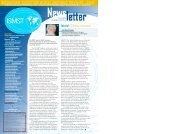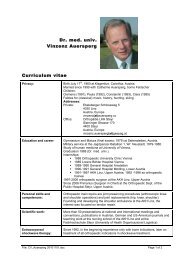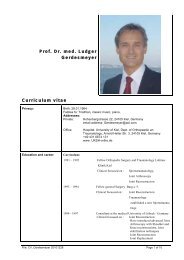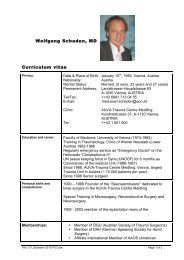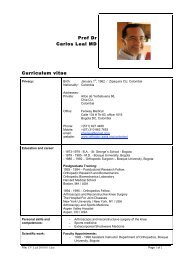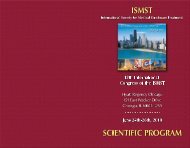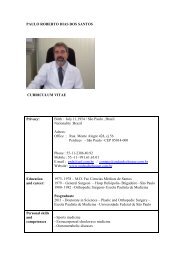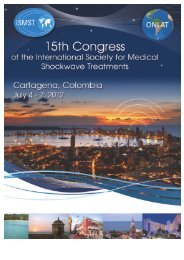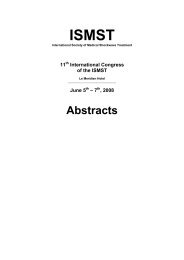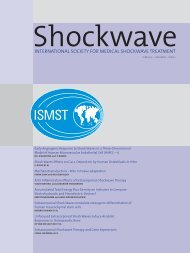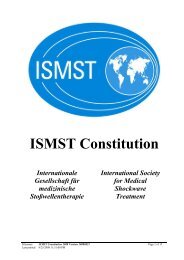Abstracts - ISMST - International Society for Medical Shockwave ...
Abstracts - ISMST - International Society for Medical Shockwave ...
Abstracts - ISMST - International Society for Medical Shockwave ...
You also want an ePaper? Increase the reach of your titles
YUMPU automatically turns print PDFs into web optimized ePapers that Google loves.
<strong>Abstracts</strong><br />
given to both groups. They were advised to start stretching exercises <strong>for</strong> the plantar fascia 2 weeks after the last treatment<br />
session and that exercises should continue <strong>for</strong> 6 weeks. Then they could resume their normal activities.<br />
Results: Follow up after 6 Months<br />
Group I (F ESWT): 87% were complaint free and VAS decreased to 3-4, 7.4% were significantly better, 3.7% were slightly<br />
better and 1.9% were unchanged.<br />
Group II (R ESWT): 85.1% were complaint free, 5.6% were significantly better, 3.7% were slightly better, and 5.6 % were<br />
unchanged<br />
There were no device related problems, systemic or local complications <strong>for</strong> either device.<br />
Discussion: Both Focused & Radial ESWT produced significant clinical improvements and relief of pain <strong>for</strong> plantar fasciitis.<br />
Significant decrease in length of spur (in X-ray) was also reported <strong>for</strong> those treated by Focused ESWT.<br />
Conclusion: This study provides some evidence <strong>for</strong> focused extracorporeal shock wave treatment being superior to radial<br />
extracorporeal <strong>Shockwave</strong> Therapy <strong>for</strong> chronic plantar fasciitis with heel spur. However more research is required on this<br />
subject, and there are methodological limitations that prevent specific device comparisons.<br />
12. ESWT in Chronic Proximal Plantar Fasciitis – 9 years of experience<br />
José Eid<br />
Institution:<br />
Clinica Ortopedica Sao Paulo, Brasil<br />
Device and producing company: Swiss Dolor Clast - EMS; Epos Ultra - Dornier<br />
Introduction: Compare the efficacy of ESWT in Proximal Plantar Fasciitis between two different generators with similar<br />
levels of energy and number of sessions.<br />
Methods: Between January 1999 and January 2008 we per<strong>for</strong>med 717 sessions of ESWT in 239 patients.<br />
Criteria <strong>for</strong> inclusion and exclusion are well known and based in <strong>ISMST</strong> protocol.<br />
An electromagnetic generator (EMSE) was used on 90 patients between 1999 to 2005, and an electropneumatic device<br />
was used on 149 patients between 2004 to 2008. Exclusion criteria included the inability to follow up. We excluded 48<br />
patients (35 in the EMSE group and 13 in the electropneumatic group) there<strong>for</strong>e this study was completed on 191 patients.<br />
The age variation was between 20 and 80 years (average: 52.8 years), 115 patients were female (59.8%), 76 were male<br />
(40.2%), and there was no significant prevalence between right (55%) and left (45%) sides.<br />
Method: The electromagnetic generator was a Dornier Epos ultra (frequency of 7.5 Mhz), where the therapy head was<br />
positioned on the medial side tangential to the point of pain. The electropneumatic device was an EMS Swiss DolorClast<br />
that was applied directly on the painful point. The energy applied with the EMSE and Electropneumatic devices was 0.22<br />
mJ/mm2 and 0.18 mJ/mm2, respectively. We applied 2000 SWs without anesthesia at intervals of 10 days regardless of<br />
the device.<br />
Results: The criterion was the Visual Analogue Scale, with follow up of 6 weeks, 12 weeks, 6 months, and 12 months.<br />
The efficacy was 85.2 % <strong>for</strong> the electromagnetic device and 84% <strong>for</strong> the electropneumatic device. There was moderate<br />
and transitory pain during the treatment. No patients presented with hematoma or petechia after application of ESWT.<br />
There are no complications or side effects with this method.<br />
Discussion: The results show good to excellent efficacy with both devices, using the same energy levels and number<br />
of SWs. Although the discussion of focal or radial device exists, it seems that there are only differences in the physical<br />
principles; the biological and clinical response seems to be the same.<br />
Conclusion: ESWT is an effective treatment method <strong>for</strong> CPPF. The therapy head, whether positioned in-line or tangentially,<br />
shows the same results as when SWs are applied directly to the point of pain.<br />
ESWT should be considered a real method of choice.<br />
This study shows relevant clinical evidence independent of the type of SW generator.<br />
17



